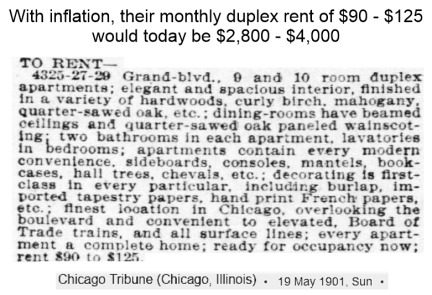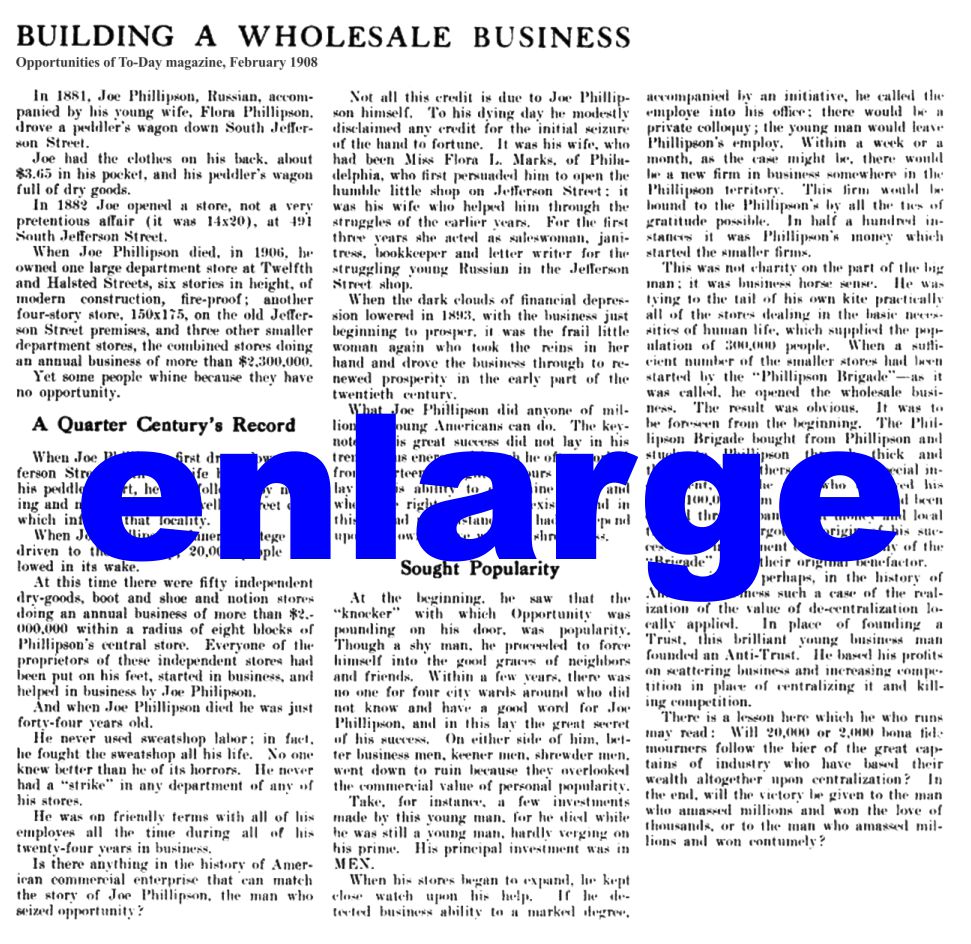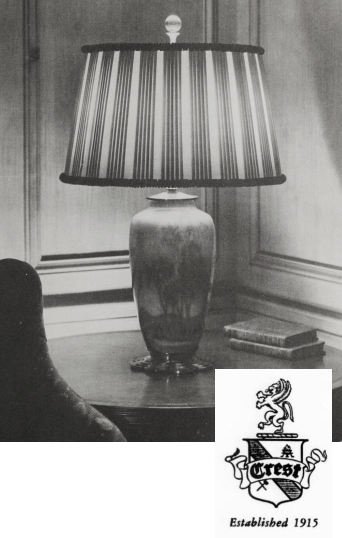|
nearly six hundred members of
the Iroquois Theater audience would lose their lives
that afternoon, but few fatalities or serious
injuries came from first-floor seats. Many
from there, like the Phillipson party, lost nothing
but their coats. Lillian, the youngest, became
separated from the family and was briefly thought to
be a victim. According to one newspaper, the
girl made it to the Union Hotel (probably referring
to the Grand Union Hotel in the former Music Hall
building on Randolph street) then somehow found her
family. Other stories connected the Phillipson
family to the more distant Continental Hotel. There
were many discrepancies in reports about the
family's Iroquois experience, but the appearance of
Lillian's name on missing lists suggests she was
missing for a few hours.
Many errors
Some newspapers reported there were three rather than
four Phillipson daughters. Francis became Florence. Flora
was at the Continental hotel sobbing for her children as others
searched for them in area stores, but she found
Lillian in a drugstore, dead, and left her there (!)
All three girls were missing; only Lillian was
missing. By some reports Flora's hysteria
might have contributed to erroneous information. If
so, it was a temporary response to her fear. A
lifetime of shrewd business activity says Flora
Phillipson was not a flibbertigibbet.
Flora
I've failed to learn much
anything about Flora's childhood. She was the
daughter of immigrants Joseph and Theresa Marks, and
had at least two siblings, Isaac and David. One
story stated she was from Philadelphia but the 1900
U.S. Census reported she was born in New York. The
same census has Joseph emigrating in 1875 but his
naturalization filing reported 1867. Flora might
have had a fuzzy recollection of when Joseph
emigrated, and Joseph might have been mistaken about
the state of Flora's birth but another possibility
is that the oldest daughter, Francis, then sixteen,
supplied the information to the census enumerator.
Team Flora and Joseph
Married in 1882 to Joseph Phillipson (1861-1906), Flora's
family in 1903 lived in a ten-room duplex at 4325-27 Grand Blvd in
the Humboldt Park neighborhood in northwest Chicago.

Joseph continued doing business on the near west
side. He employed Polish-speaking workers and his
customers were as familiar as family. The series of
Phillipson dry goods stores from 1882 to 1906 were
located in this Maxwell street area, called "the
ghetto," where his parents, Phillip and Rachel
Phillipson, settled after immigrating from Poland
c.1867. It was there that Joseph and his brother,
Samuel Phillipson (1866-1936), had worked as
teenagers, learning the dry goods peddling business
from the ground up by helping their father peddle
merchandise door to door, carrying packs on their
backs. It was there that Flora, yet a bride, helped
Joseph work the peddling wagon and in 1882 urged him
to set up his first store, a 14 x 20 structure at
491 S. Jefferson St. that sold notions at retail and
wholesaled to other peddlers. Reportedly Joseph
credited Flora as critical to his success. In the
early years and again during the 1893 depression,
she served as saleswoman, janitor, bookkeeper, and
secretary.
The first new construction for a Phillipson store
was in 1897 at the southwest corner of Jefferson and
Dussold, a $35,000 four-story building designed by
Cowles & Ohrenstein. It was attached to an existing
structure, producing an 85'x125' store.
Three years before the Iroquois fire, Joseph had
leased a building on Chicago's Jefferson and O'Brien
streets. It had been the city's only Yiddish
playhouse and the manager of the theater was angry
to be ejected, but Joseph prevailed and annexed the
structure to their six-story dry goods store facing
Jefferson. The store was described as the first big
department store in the "ghetto."†
|
Both Flora's husbands kept such low profiles in the
media that learning about them is
difficult - and for a man with as many
employees and business associates as
Joseph Phillipson, such aversion to
publicity was unusual.
So much so that I went looking for an
explanation and may have found a clue in
a description of Flora's second husband.
About Samuel Zwetow it was said that he
abided by the Talmud and avoided
aggrandizement. Perhaps Flora was
drawn to that characteristic in Sam as
she had been to it in Joe thirty-eight
years earlier.
Aggrandizement do thou avoid!
A name made great's a name destroyed.
Aboth I.13 (1894 Isadore Myers
translation of the Talmud)
|
In the years after the fire
A year after the Iroquois fire, Joseph took out a ten-year loan to
build a new $150,000 store on the northeast corner
of Halsted and Twelfth. It was described as a sign
that merchants were ready to bring big State street
type department stores to distant neighborhoods. He
lived to see it in operation for only a few months.
A brief obituary notice stated that a fuller
obituary would follow but I failed to find it. He
was in Hot Springs at the time, presumably in
Arkansas, perhaps trying to treat an ailment.
|

|
Three years and three days after the Iroquois
Theater fire, Flora purchased a box seat at the
Coliseum Theater to attend a benefit for the Jewish
Old People's Home on Albany and Ogden avenues. She'd
been active in Jewish society from the early days of
her marriage, serving as vice president of the
Hebrew Ladies Aid Society in 1890, but the Jewish
Old People's home was special. Joseph had been one
of the organization's founders, and an officer. He'd
been gone for ten months and Flora, ever the
helpmate, donated $5,000 to the home.
Joe Phillipson exceptional
An estimated 20,000 people joined the February 1906 funeral
entourage for Joseph Phillipson. They were the shopkeepers,
employees and families he'd helped get started over
the prior two decades, resulting in fifty
shopkeepers stores within an eight-block radius of
the Phillipson store.
 They included five millinery shops and multiple shoe and
boot stores, generating an estimated $2 million in
annual sales. Many had begun as employees at the
Phillipson store, recognized by Joseph as having
good business sense. Known as the Phillipson
Brigade, they became his loyal customer base
when he later opened a wholesale branch.
They included five millinery shops and multiple shoe and
boot stores, generating an estimated $2 million in
annual sales. Many had begun as employees at the
Phillipson store, recognized by Joseph as having
good business sense. Known as the Phillipson
Brigade, they became his loyal customer base
when he later opened a wholesale branch.
Flora sells Joseph's baby
At Joseph's death. Flora had four daughters aged
thirteen to twenty-two to continue raising and
see wed. She held out for three years, running
the store herself then, in March, 1909, sold the
stock and fixtures of the Joseph Phillipson Department store and the warehouse on
Jefferson and O'Brien, the former site of the
Yiddish theater, for $339,757 ($9 million today)
plus a twenty-year $19,000 annual lease on the
property. It was heralded as the largest deal of its
kind in the ghetto district. The buyers: Henry
Isaacs, owner of Fairbanks department stores in
Alaska and Joseph Weissenbach, son-in-law of Leon
Klein, owner of Joseph's primary competitor, the L.
Klein department store a block away at Halsted and
Fourteenth streets. The new owners changed the name
to "The Twelfth Street Store."
The decision to sell the store may have been
difficult for Flora. She surely considered
continuing to run the store herself. As a woman
living in Illinois, unlike some other states, she
could own property and control her earnings, but it
would have been hard work regardless of gender.
Joseph's store was a much larger entity in 1906 than
it had been when she worked there in 1893. Many more
employees and customers, much more inventory.
And two sets of brothers. There were Joseph's
brothers, Samuel and Louis Phillipson (1874-1941),
and Flora's brothers, Isaac and David Marks. Samuel
had been a silent partner in Joseph's company (a
silence ended after his brother's death when he
seemed to want shared credit for his role in the
venture's success), and Louis was in management.
Both men may have had ideas about a future role.
Isaac L. Marks (1859-1916), had operated a dry goods
store in Brooklyn before he and his wife, Minnie
Smith Marks, relocated to Chicago in 1908. Did Isaac
and David come to Chicago in expectation of having a
role in Joseph's store? In September, after the
sale, Isaac and a third Marks child, David J. Marks,
formed the Marquette Motor Vehicle company to
manufacture automobiles and engines at 3626 S.
Halstead (no connection to the Marquette-Buick),
capitalized with $20,000 that may have come from
Flora. They exhibited at the 1910 & 1911 Chicago
Auto show, and one of their delivery wagon trucks
ran a reliability race that year. Three years later,
they were out of business. Samuel Phillipson started
over with a wholesale company and a retail
department store, Samuel Phillipson & Bro. He
prospered for two decades, but the business failed
during the 1929 Depression. The name of the retail
store suggests Louis was involved but Samuel made a
point of identifying himself as the sole owner. Am
thinking Samuel may have been a bit less orthodox
than Joseph.
It would be interesting to know what factors
motivated Flora to sell Joseph's store. Perhaps
Joseph had built an empire that could only be run
properly by Joseph. Maybe she didn't want to juggle
two brothers and two brothers-in-law. Or maybe Flora
had just had her fill of dry goods and operating a
business. She'd watched her husband die at an early
age so maybe decided to do a bit more living before
her time came.
Flora and her girls moved to the
Chicago Beach Hotel in the Kenwood neighborhood,
a luxury hotel built for the 1893 Columbian Exposition.
In 1919, thirteen years after Joseph's death, at age forty-nine, Flora
remarried, to widower Samuel R. Zwetow, a wholesale
jeweler and insurance broker from Denver - of a
similar age to Joseph and also a Russian immigrant.
(Zwetow is sometimes Americanized to Sweet.) In 1921
they left Denver and returned to Chicago. Both died
in 1929 and were buried next to their respective
first spouses, Flora in Rosehill Cemetery in Chicago
next to Joseph, and Samuel in Denver's Congregation
Emanuel Cemetery next to Annie Rubinsky.
Lillian bore two children with Samuel L. Dinkelspiel
(1891-1961), son of a Louisville cloth and hides
wholesaling family. Samuel became a producer of
antique reproduction furniture and lighting,
including his Legacy Lighting line, examples of
which turn up today at auctions and flea markets.
In 1917 he announced that Crest Company would no
longer manufacture furniture and would concentrate
on floor lamps. Table lamps were added later.
 In 1939 the Crest Company table lineup included this Eucalyptus theme Rookwood
Pottery lamp. The vase portion was 14" high with an
8" glass reflector and crystal ball finial. From top
to bottom it was 30.5"c high.
In 1939 the Crest Company table lineup included this Eucalyptus theme Rookwood
Pottery lamp. The vase portion was 14" high with an
8" glass reflector and crystal ball finial. From top
to bottom it was 30.5"c high.
~~~~~~~~~~~
Adeline married grocer Harry Futchenfeld /
Feilchenfeld in 1909
(later shortened to Field) with
whom she had two children, including a daughter
named after Flora.
Francis married jeweler Maurice A. Barnett two and a half years after the fire.
One of their two children was named Joseph, after
his grandfather.‡
Theresa, likely named after her grandmother, Theresa Marks, married
stockbroker Alexander Kieferstein (later
shortened to Kiefer), with whom she had two
children.
|
|
The name Phillipson was sometimes spelled with just one L and
the spelling of Flora's maiden name was sometimes
given as Marx. Frances' name was sometimes spelled
as Francis. Joseph Phillipson employed a manager
named Marks that was perhaps a relative of Flora's.
The Phillipson's had lost four children prior to the
fire, including Ruth who died in infancy in 1899 and
Mark who died at age three in 1889.
Joseph Phillipson's mother, Sarah Rachel, died in 1899 and his father, Philip
Feivel Phillipson (c1830-1903), followed in 1903, six months before the Iroquois
fire. Philip was from Kalwaria Zebrzydowska in
southern Poland. Joseph and Samuel's youngest
brother, Louis, also worked in Joseph's store.
† This1891
description of Chicago's ghetto is filled with
insensitive generalizations of a type that were once
common but helps provide a picture of the
scene in the ghetto when Joseph and Flora Phillipson
were building their business. For a historical
perspective of Chicago's Jewish community, see the
American-Israeli Cooperative Enterprise (AICE)'s
Virtual Library discussion. It is not
known what motivated Philip and Rachel Phillipson's
mid 1860s emigration but a
Library of Congress site provides an overview of
the situation in their native country twenty years
later. Just found a copy on Ebay of the 1996 The Jews of Chicago: from shtetl to suburb by
Irving Cutler for $9 including shipping.
You can read an excerpt here.
‡ Maurice Barnett was in 1930 convicted of insurance fraud after
masterminding a 1929 conspiracy with two partners to
stage a fake holdup. He was sentenced to the state
penitentiary for one to five years. Multiple appeals
over thirty-two months kept him out of jail until
November, 1933 when the governor denied his petition
for parole and he was sent to the prison in Joliet.
He was out of jail by Feb, 1936, in time to post
bail for his son in a marital dispute. Maurice and
Francis later moved to Los Angeles.
|
|
What was a dry goods store?
With clothing and textiles as the mainstays, and women as the
primary customers, dry goods stores also
specialized in what we today call house
wares, i.e., dining utensils, cookware, bed
linens and sundries (toiletries, newspapers
and other low priced items). Think
Kohls. Dry goods stores at the turn of
the twentieth century also offered
"everything else" that was either not
offered in such specialty stores as
hardware, grocery, furniture, jewelry,
millinery shops or bookstores, or that was
priced to appeal to shoppers more
constrained by time or budget. A
diamond engagement ring was apt to come from
a jewelry store but a $2 rhinestone brooch
could be picked up during a shopping trip
for a new mackintosh and a replacement sugar
bowl. Hardware stores offered dozens
of hammers for all types of carpentry; dry
goods stores offered a handful of tools for
simple household repairs. In rural
areas with few specialty stores, dry goods
stores made up for it, offering whatever
merchandise the community was willing to
buy. To shopkeepers, the emergence of
mail-order catalog houses such as Sears,
Spiegel and Montgomery Ward must have seemed as
cataclysmic as internet sales have been in
modern times. This 1899
Wrecking House dry goods catalog is one
example.
This 1893-94 Carson Pirie Scott catalog
is an example of a retailer with a
foundation in "bricks and mortar"
trying to get in on the shop-from-home market.
Some of the inventory clusters seem peculiar
— like over two dozen models of accordions and over three
dozen smoking pipes.
|
|
